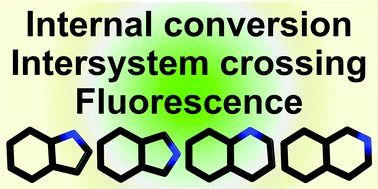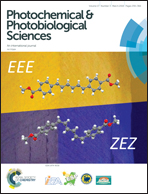Exploring radiative and nonradiative decay paths in indole, isoindole, quinoline, and isoquinoline†
Abstract
Radiative and nonradiative decay paths from the first excited singlet electronic state (S1) in four heteroaromatics, indole, isoindole, quinoline, and isoquinoline, were systematically explored. Three decay processes, i.e., internal conversion (IC), intersystem crossing (ISC), and fluorescence emission (FE), were compared. Minimum energy conical intersection structures between the electronic ground and first excited states were investigated to determine the most preferred IC path. The minimum energy seam of crossing (MESX) geometries between S1 and the lowest-lying triplet states and the spin–orbit couplings at these MESX structures were computed to identify the most feasible ISC path. The oscillator strength was calculated at each S1 local minimum to reveal the contribution of the FE process. The calculations clearly showed that indole had the highest fluorescent quantum yield, consistent with the experimental data. The present calculations also explained other experimental properties of the heteroaromatics such as ISC quantum yields.



 Please wait while we load your content...
Please wait while we load your content...